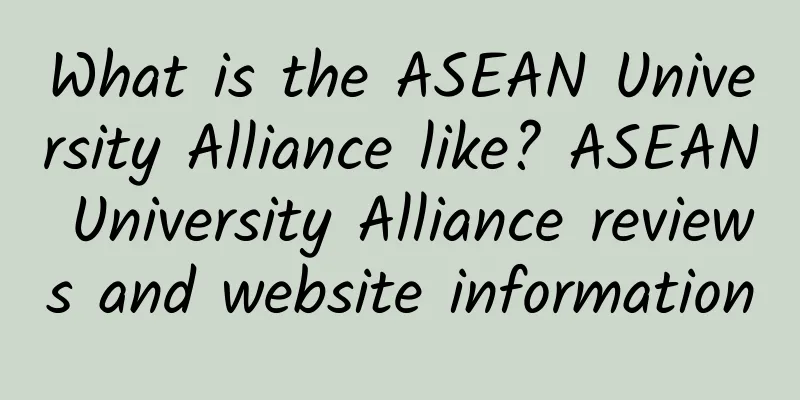What is the ASEAN University Alliance like? ASEAN University Alliance reviews and website information

|
What is the ASEAN University Network? The ASEAN University Network (AUN) is a university alliance in Southeast Asia. It was founded in 1995 by ASEAN member states. Its secretariat is located in Chulalongkorn University in Thailand. It aims to promote exchange learning and cooperative research in priority development areas identified by ASEAN countries and strengthen cooperation among ASEAN universities. Website: www.aunsec.org ASEAN University Network: A model for regional education cooperationFounded in 1995, the ASEAN University Network (AUN) is one of the most influential cooperation platforms for higher education and research institutions in Southeast Asia. As an important mechanism for strengthening academic exchanges, promoting education quality and promoting regional integration among ASEAN member states, AUN has played a vital role in the past few decades. This article will explore the historical background, organizational structure, core objectives, main activities of the ASEAN University Network and its significance in the context of globalization. The Origin and Development of the ASEAN University AllianceThe creation of AUN can be traced back to 1995, when the ten ASEAN countries realized the importance of cooperation in the field of higher education for achieving regional economic and social development goals. In order to meet the challenges brought by globalization and enhance the connection and collaboration between universities in the region, ASEAN member states jointly decided to establish a regional university network. This initiative was supported by the United Nations Educational, Scientific and Cultural Organization (UNESCO) and eventually led to the birth of AUN. The AUN Secretariat is located at Chulalongkorn University in Bangkok, Thailand, and is responsible for coordinating and managing the affairs of the alliance. Since its establishment, AUN has continued to grow and develop, and currently more than 30 top universities from ASEAN member states and dialogue partner countries have joined it, becoming an important link connecting higher education resources in Southeast Asia and even the wider region. Core objectives of the ASEAN University AllianceThe core goal of AUN is to achieve the overall development of the ASEAN Community by promoting academic exchanges, improving education quality and promoting regional cooperation. Specifically, AUN is committed to the following aspects:
These goals not only reflect the common vision of ASEAN countries for the development of higher education, but also provide clear direction for AUN's work. Main activities of ASEAN University AssociationAUN achieves its goals through a variety of activities and projects. The following are some of the main areas of activity of AUN: 1. Academic Exchange and CooperationAUN regularly holds various academic conferences, seminars and workshops to provide a communication platform for scholars, researchers and managers from member universities. For example, the AUN Annual Meeting brings together ministers of education, university presidents and other stakeholders from member countries to discuss the opportunities and challenges facing regional higher education. In addition, AUN has established working groups in a number of professional fields, such as environmental science, public health, engineering technology, and humanities and social sciences, aiming to deepen collaborative research and innovative practices in specific disciplines. 2. Quality Assurance and CertificationTo ensure the consistency of higher education quality in the region, AUN has established a dedicated Quality Assurance Framework, which includes a set of detailed evaluation indicators and procedures to review the teaching, research and service performance of member universities. AUN-QA (ASEAN University Network Quality Assurance) is one of the flagship projects launched by AUN, which aims to help member universities establish and improve their internal quality assurance systems and provide guidance and support for external evaluations. Through this project, AUN has successfully promoted many universities to obtain internationally recognized quality certification. 3. Student and Faculty MobilityAUN attaches great importance to the transnational mobility of students and teachers, and has launched a number of exchange programs and scholarship programs. For example, the AUN/SEED-Net (Southeast Asia Engineering Education Development Network) program provides short-term exchange and training opportunities for engineering students and teachers; while the AUN Student Mobility Program supports undergraduate and graduate students in credit transfer and joint training between universities in different countries. In addition, AUN actively advocates the development of dual degree and joint degree programs, enabling students to obtain academic certificates from two or more countries at the same time, thereby enhancing their competitiveness in the global job market. 4. Social Responsibility and Community ServiceAUN encourages member universities to actively participate in social responsibility activities and bring practical benefits to local communities through knowledge dissemination and technology transfer. For example, the AUN Community Engagement Program is committed to translating university research results into actionable solutions to address issues such as poverty, disaster management and environmental protection. At the same time, AUN also supports youth leadership training and development programs to cultivate the next generation of leaders with global vision and sense of responsibility. Achievements and Impact of the ASEAN University AllianceAfter more than 20 years of development, AUN has achieved remarkable achievements in many aspects and has had a profound impact on higher education and overall social development in Southeast Asia:
These achievements fully demonstrate the value and role of AUN as a regional education cooperation platform. Future prospects of the ASEAN University AllianceIn the face of an increasingly complex global environment and rapidly changing technological trends, AUN will continue to uphold the principles of openness, inclusiveness and innovation to further expand its areas of cooperation and influence. The following are several key directions for AUN's future development: 1. Strengthen digital transformationWith the rapid development of information technology, AUN will pay more attention to promoting the digital transformation of member universities, including the construction of online education platforms and the development of virtual laboratories. This will not only help improve teaching efficiency and coverage, but also provide more learning opportunities for students in remote areas. 2. Deepen interdisciplinary collaborationTo address complex social issues, AUN will encourage member universities to conduct more interdisciplinary collaborative research, especially in the fields of artificial intelligence, big data analysis and climate change adaptation. This multi-dimensional perspective and approach will help produce more innovative and practical research results. 3. Expanding the partnership networkAUN plans to strengthen cooperation with other international higher education organizations and enterprises to attract more resources and expertise to support the development of the alliance. For example, establishing strategic partnerships with institutions such as the European University Association (EUA) and the Association of American Universities (AAU) can provide AUN members with more learning and reference opportunities. 4. Promote the achievement of sustainable development goalsAs a supporter of the United Nations 2030 Agenda for Sustainable Development, AUN will be committed to promoting gender equality, reducing inequality and protecting the ecological environment through education and research. This will require the joint efforts and continuous investment of all member universities. ConclusionThe ASEAN University Network is not only a symbol of higher education cooperation in Southeast Asia, but also a successful case of regional education integration in the world. From the initial conception to the current large network covering more than 30 top universities, AUN has always adhered to the core mission of promoting academic exchanges, improving education quality and social responsibility, and has made an indelible contribution to the construction of the ASEAN community. Looking ahead, AUN will continue to explore new cooperation models and innovative paths to adapt to the ever-changing needs and challenges in the context of globalization. We have reason to believe that with the joint efforts of all member universities, AUN will usher in a more brilliant future. For more information about the ASEAN Universities Alliance, please visit its official website: www.aunsec.org . |
Recommend
How to make pork jelly and the ingredients and steps
Many people like to eat some refreshing pork skin...
What is the Pew Research Center like? Pew Research Center reviews and website information
What is the Pew Research Center website? The Pew R...
How is HMS Industrial Networks? HMS Industrial Networks reviews and website information
What is the website of HMS Industrial Networks? HM...
How to cultivate net-veined grass? Detailed explanation of the cultivation method of net-veined grass
There are many varieties of net-grass, one of whi...
How is Morinaga Milk? Morinaga Milk reviews and website information
What is Morinaga Milk Industry? Morinaga Milk Indu...
The benefits of eating olives
Olives are fruits of the olive tree. Because of t...
What is Wolverhampton Wanderers Football Club like? Wolverhampton Wanderers Football Club reviews and website information
What is the website of Wolverhampton Wanderers Foo...
How is Lan Gan Xing's university? Lan Gan Xing's university reviews and website information
What is the website of Ramkhamhaeng University? Ra...
How is the Chinese Embassy in Slovakia? Reviews and website information of the Chinese Embassy in Slovakia
What is the website of the Chinese Embassy in Slov...
How to make and preserve dried cherry tomatoes
I believe everyone has eaten dried cherry tomatoe...
How is Estee Lauder? Estee Lauder reviews and website information
What is the Estee Lauder website? Estee Lauder is ...
What is the International Centre for Theoretical Physics like? International Centre for Theoretical Physics reviews and website information
What is the website of ICTP? ICTP is an internatio...
The efficacy and function of Qingxu grapes
Qingxu is a key county in Shanxi Province and the...
How is Pierre and Marie Curie University? Pierre and Marie Curie University Reviews and Website Information
What is Pierre and Marie Curie University? Pierre ...
Benefits and functions of fresh coconut juice
Coconut is a fruit that is native to tropical reg...









